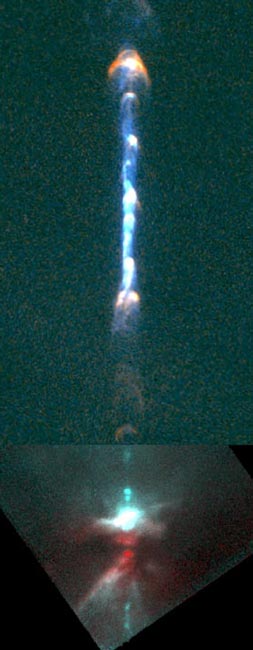Explanation: The complex interactions of three stars in the Orion B molecular cloud complex have resulted in the ejection of particles along a 12 light-year long jet. One of the stars in the HH111 system has apparently also been ejected leaving two stars tightly bound in a binary orbit. The spectacular jet emanates from one of these two stars. The complete system is quite complex and involves another less-luminous jet and disks of rapidly rotation gas. In the top part of this Hubble Space Telescope image taken in visible light, successive bubbles are seen to move along the jet. At the bottom in infrared light, a torus of dark dust and gas from which the stars formed millions of years ago can be seen. Protons and electrons zip along near 500 kilometers per second in the HH111 jet, which is about 1500 light-years away.
1999 2000 2001 2002 2003 2004 2005 2006 2007 2008 2009 2010 2011 2012 2013 2014 2015 2016 2017 2018 2019 2020 2021 2022 2023 2024 2025 |
Yanvar' Fevral' Mart Aprel' Mai Iyun' Iyul' Avgust Sentyabr' Oktyabr' Noyabr' Dekabr' |
NASA Web Site Statements, Warnings, and Disclaimers
NASA Official: Jay Norris. Specific rights apply.
A service of: LHEA at NASA / GSFC
& Michigan Tech. U.
|
Publikacii s klyuchevymi slovami:
jet - Herbig-Haro object - star - Molekulyarnye oblaka - molodye zvezdy - dzhet - strui - Ob'ekt Herbiga-Aro
Publikacii so slovami: jet - Herbig-Haro object - star - Molekulyarnye oblaka - molodye zvezdy - dzhet - strui - Ob'ekt Herbiga-Aro | |
Sm. takzhe:
Vse publikacii na tu zhe temu >> | |
